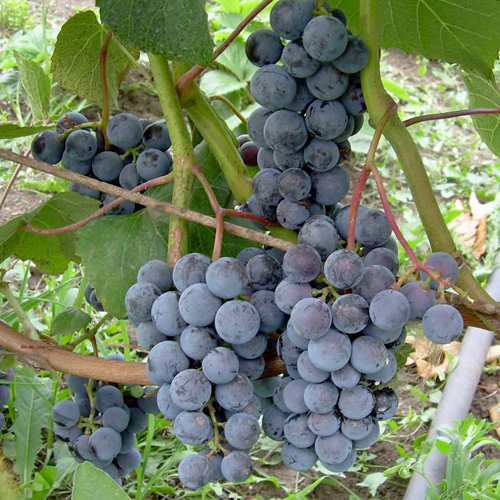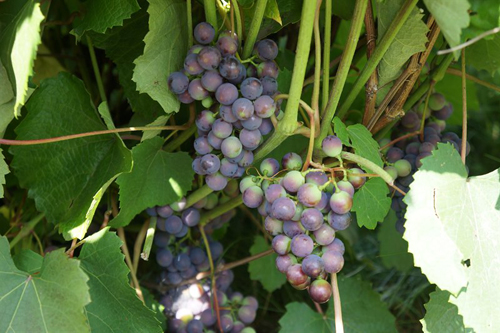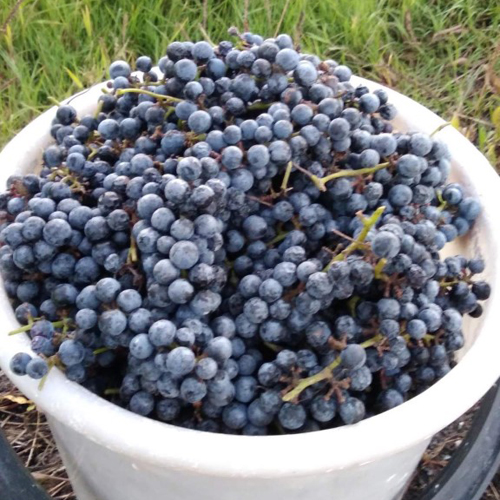Grape variety Taiga
The Taezhny variety is a variety of Amur grapes, discovered and introduced into cultivation by the breeder of the Suifuno-Ussuriyskaya fruit and berry station Nikolai Nikolaevich Tikhonov, a follower and student of I.V. Michurin. The researcher made this discovery back in 1933 in the south of Primorskaya taiga. Since then, the form has become widespread in many regions of northern viticulture, where it has demonstrated its early maturity, unpretentiousness, good fruit quality for the still recently wild grapes and the versatility of harvest use. Plants bear fruit very abundantly, and from each bush you can get up to a centner of ripe bunches. In addition to productive cultivation, it is also well suited for landscaping in regions with very harsh climates.

Agrobiological properties
Bushes with high vigor, abundant vegetative mass and deep root systems. The shoots are powerful and very long. Leaves are medium and large, rounded, consist of three, less often of five lobes, the dissection between which is low. The upper side of the leaf blade is finely bubbly, dark green with slightly lighter veins. The pubescence on the dorsum is not noticeable. The leaf profile is funnel-shaped, but the edges of the lobes are often hanging down. The upper lateral notches are of medium depth, open, most often V-shaped, sometimes lyre-shaped with a rounded bottom. The lower notches are either barely outlined or absent. Many leaves can grow without dissection at all. The petiolate notch is vaulted or lancet. The petioles are long and thin, green in color, rarely with a weak anthocyanin tint. The denticles along the perimeter of the leaf blade are small, triangular, with sharp tops and straight sides. The flowers are functionally feminine, which suggests an insufficient level of pollination. However, Taezhny refutes this common stereotype, showing excellent fruit set, provided that there are bisexual varieties in the neighborhood that bloom at the same time. Annual shoots ripen well, acquiring a brown-brown color in the process.
The bunch of Taezhnoye grapes is medium in size, loose in structure and cylindro-conical in shape. The usual weight of a standard brush is about 150 grams. The largest ones can reach 250 g. Due to the free arrangement, the berries do not damage each other and do not deform. The comb is rather long, green, not lignified. The berries are small, rounded, about 16 mm in diameter, black or dark blue, covered on the outside with a layer of bluish prune bloom. The weight of one hundred grapes is 250 - 350 grams. The pulp of the fruit is quite tender and juicy, the taste is balanced - sweet and sour, in the aroma, according to some testimonies, you can catch light nutmeg tones. The sugar content in the squeezed juice is high - up to 20g / 100 ml, but the sweetness in the taste is emphasized by a noticeable acidity. The berries also contain a significant content of pectins. The skin of the grapes is eaten. The bones are present, up to three pieces. The taste is average, which is quite forgivable for an unpretentious northern variety.

The harvested crop can be used both directly for food and processed into delicious compotes, preserves, and jams, wonderful in gastronomic terms and very rich in color. Rich in vitamins and minerals, these blanks will come in handy in winter. In addition, many owners make dry red homemade wine from Taezhnoye. It turns out to be quite good in quality, which is facilitated by the good balance of sugar and acid in the wort. Due to the sufficient level of alcohol, the finished drink shows stability in storage. The aroma of this wine is very fragrant and unique in its own way. Some gourmets, however, notice in the bouquet the so-called "Labrus" tones, which they consider unpleasant for their perception. However, most winegrowers do not pay attention to this.
Ripening of grapes occurs very early. A seaside hero needs only 90 - 92 days after budding in the spring to reach technical ripeness. The sum of active temperatures during this time does not exceed 2000 ° C, which allows Taezhnoye to mature in the north of the European part of our country, in many regions of the Urals and Siberia. An additional advantage here is the tremendous frost resistance of the vine, reaching -35 ... -40 ° С. It allows you to cultivate plants without shelter, even in the harshest conditions, where the southern varieties would hardly survive the winter, even warmed.
The yield of the variety is very high, due to the gigantic dimensions of adult bushes, as well as a significant number of inflorescences forming on the shoots. So, the fruiting factor can reach 2.5 - 3.5 bunches per vine, and limiting their number is not required due to the fantastic vital energy of plants. As a result, by the seventh to eighth year after planting, you can get up to 100 kg of grapes from each bush without signs of overload. After ripening, the bunches can continue to hang freely on the vine until the very frost. The berries are not prone to cracking or decay, so that even heavy rains and a sharp drop in soil moisture cannot harm them.

Agrotechnical features
The cultivation of the Taiga area does not require much effort and a high level of skill from the grower.
A variety of soil types are quite suitable for placement, both in terms of fertility and mechanical composition. The only thing you need to pay attention to when choosing a place for planting is the absence of waterlogging of the soil, and even more so of its swampiness, including those associated with shallow groundwater.
The variety propagates easily by rooting cuttings. During planting, its ability for unlimited growth is taken into account, and therefore a significant area of land is allocated for each bush in order to exclude competition between plants for light, moisture and nutrients in the future.
Growing bushes are formed according to non-covering high-standard patterns with long lateral cordons. Excellent results are also shown by arched and arbor formations, in which the vegetative mass of plants also performs a decorative function.
Fruiting bushes are cut off medium (6 - 8 buds) or short (3 - 5 eyes). After the start of growth, it is advisable to remove weak and sterile shoots, but it is not necessary to thin out the brushes on fertile vines. The fight against diseases and pests is practically not required, due to the increased resistance of Taezhnoye to pathogens, and only in the first years of life, young plants will need preventive treatments against mildew.








